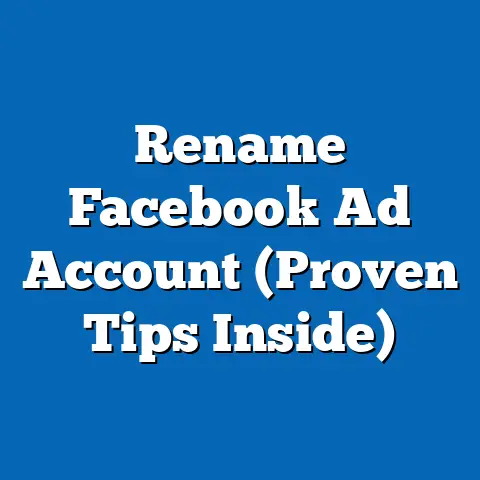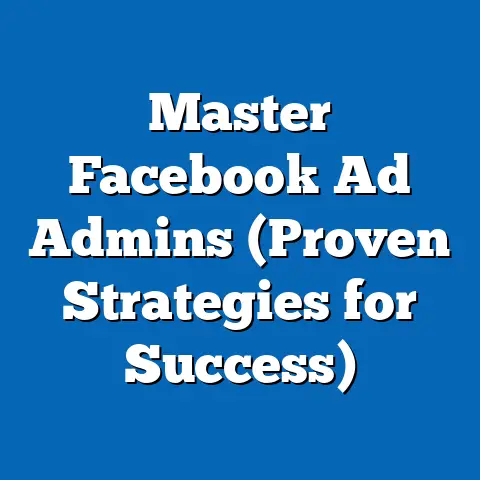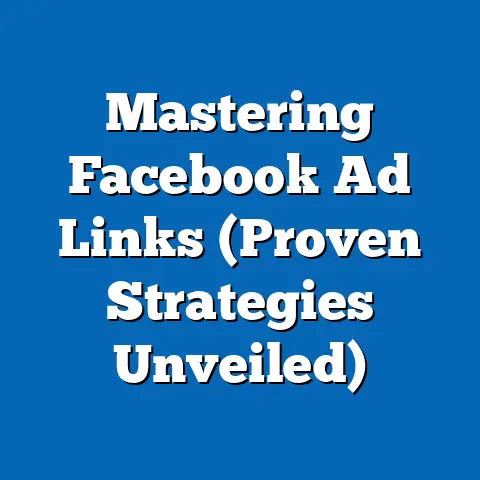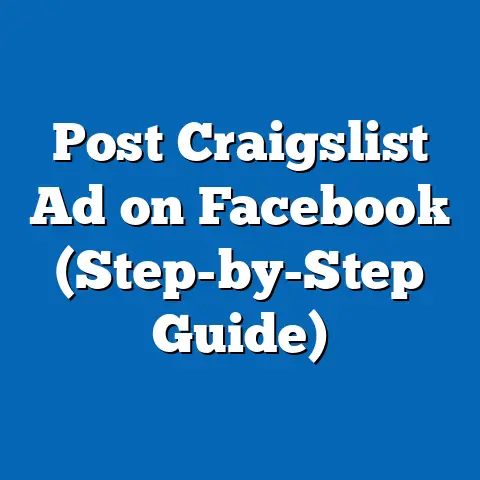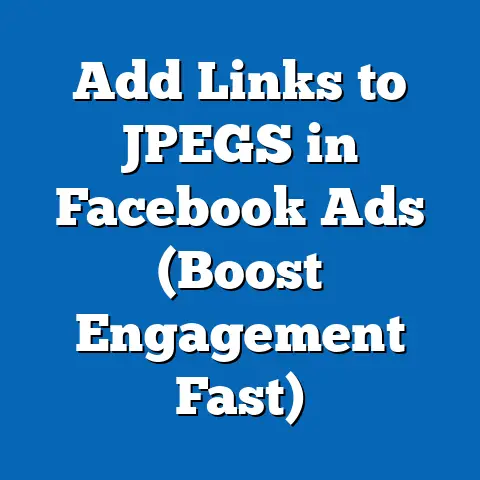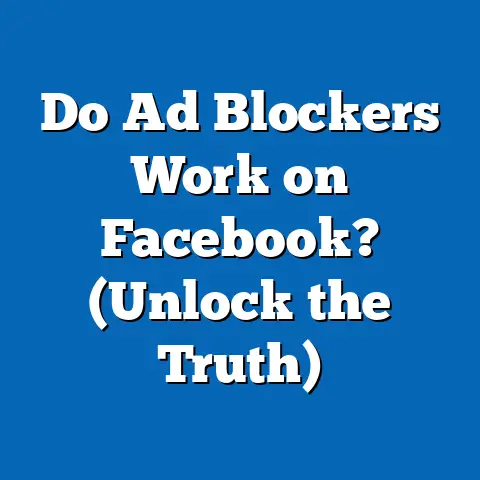What You’ll Really Spend on Facebook Ads (Cost Breakdown)
In today’s digital age, businesses of all sizes find comfort in the accessibility and scalability of online advertising platforms like Facebook Ads. With over 2.9 billion monthly active users worldwide as of Q2 2023 (Statista, 2023), Facebook offers an unparalleled opportunity to reach diverse audiences with precision targeting. For small businesses and entrepreneurs, the platform provides a sense of security—an affordable entry point into digital marketing with the potential for significant returns.
However, the comfort of advertising on Facebook comes with a critical caveat: understanding the true costs involved. Many advertisers, especially newcomers, underestimate the expenses tied to running effective campaigns. This article dives deep into the real costs of Facebook Ads, breaking down key factors, trends, and demographic considerations to provide a clear picture of what you’ll spend.
Section 1: The Growing Popularity of Facebook Ads
Key Statistics and Trends
Facebook Ads have become a cornerstone of digital marketing strategies, with businesses spending billions annually to tap into the platform’s vast user base. According to eMarketer, global ad spending on Facebook reached $84.2 billion in 2022, accounting for nearly 20% of total digital ad spending worldwide. This figure is projected to grow to $96.5 billion by 2024, reflecting a compound annual growth rate (CAGR) of 7.1%.
The platform’s appeal lies in its versatility—businesses can run campaigns for brand awareness, lead generation, or direct sales, all while leveraging detailed demographic targeting. Historical data shows a steady increase in ad spending over the past decade, with a notable spike during the COVID-19 pandemic as businesses pivoted to online channels. For instance, ad revenue on Facebook grew by 56% year-over-year in 2021, highlighting the platform’s role as a lifeline for businesses during uncertain times (Facebook Quarterly Reports, 2021).
Demographic Insights
Facebook’s user base spans a wide range of demographics, which directly influences ad costs and campaign strategies. As of 2023, 25-34-year-olds make up the largest demographic group on the platform, representing 29.6% of users globally (Hootsuite, 2023). This age group is particularly valuable to advertisers due to its high purchasing power and engagement rates.
Gender distribution is relatively balanced, with 56.3% male users and 43.7% female users, though engagement patterns vary by region and interest. For advertisers, targeting specific demographics can significantly impact costs—ads aimed at younger audiences (18-24) often face higher competition and costs per click (CPC) due to demand, while older demographics (55+) may offer lower CPCs but require tailored messaging. Understanding these demographic nuances is essential for budgeting effectively.
Section 2: Understanding the Cost Structure of Facebook Ads
How Costs Are Determined
Facebook Ads operate on an auction-based system, where advertisers bid for ad placements based on their target audience, objectives, and budget. The primary cost metrics include Cost Per Click (CPC), Cost Per Mille (CPM, or cost per 1,000 impressions), and Cost Per Action (CPA), which measures the cost of a specific action like a purchase or sign-up. According to WordStream’s 2023 data, the average CPC across industries on Facebook is $1.72, while the average CPM is $7.19.
Costs are influenced by multiple factors, including audience targeting, ad placement (e.g., News Feed vs. Stories), and seasonality. For instance, CPCs often spike during peak shopping seasons like Black Friday and Christmas, with increases of up to 25-30% compared to off-peak months (AdEspresso, 2022). Advertisers must also consider the “relevance score” assigned by Facebook, which evaluates ad quality and engagement—higher relevance scores can lower costs by up to 20% (Facebook Business, 2023).
Budgeting Options: Daily vs. Lifetime Budgets
Facebook offers two primary budgeting options: daily budgets, which cap spending per day, and lifetime budgets, which allocate a total amount over a campaign’s duration. A 2022 survey by Social Media Examiner found that 62% of small businesses prefer daily budgets (typically $10-$50 per day) for better control, while larger brands often opt for lifetime budgets to maximize reach over extended campaigns.
Regardless of the approach, unexpected costs can arise if campaigns are not monitored closely. For example, overspending due to broad targeting or low-quality creatives can inflate costs by 15-30%, according to a 2023 report by Hootsuite. Setting clear limits and regularly optimizing campaigns are crucial to staying within budget.
Section 3: Industry-Specific Cost Variations
Average Costs by Industry
Ad costs on Facebook vary widely depending on the industry, as competition and audience behavior play significant roles. WordStream’s 2023 industry benchmark report highlights stark differences: the finance and insurance sector faces the highest average CPC at $3.77, driven by high competition for lucrative leads. In contrast, the apparel industry averages a much lower CPC of $0.45, reflecting lower competition and broader audience appeal.
Other industries like technology ($1.27 CPC) and e-commerce ($0.97 CPC) fall in the middle, though CPMs can vary based on product price points and seasonality. For small businesses in niche markets, understanding these benchmarks is critical to setting realistic budgets. A visual comparison (e.g., a bar chart of CPC by industry) would illustrate these disparities clearly, showing finance at the top and apparel at the bottom.
Historical Trends in Industry Costs
Historically, industries with high customer lifetime value (CLV), such as finance and real estate, have consistently faced higher ad costs on Facebook. A 2018 WordStream report pegged the average CPC for finance at $3.20, a figure that has risen by 17.8% over five years due to increased competition. Conversely, e-commerce CPCs have remained relatively stable, fluctuating between $0.85 and $1.00 since 2018, thanks to the sheer volume of advertisers balancing out demand.
These trends underscore the importance of long-term planning. Businesses entering high-cost industries must allocate larger budgets or focus on niche targeting to reduce expenses, while those in lower-cost sectors can scale campaigns more affordably.
Section 4: Factors Influencing Facebook Ad Costs
Audience Targeting and Size
The specificity of your target audience significantly impacts costs. Narrow audiences (e.g., women aged 25-34 interested in organic skincare) often result in higher CPCs due to limited inventory and high competition—sometimes 20-40% more than broader audiences (AdEspresso, 2023). Conversely, broad targeting can lower costs but risks irrelevant clicks, driving up overall CPA.
Demographic factors like location also play a role. Targeting users in high-income countries like the United States or Australia typically costs more (average CPC of $1.86 in the U.S.) compared to emerging markets like India ($0.51 CPC), per 2023 data from Statista. Advertisers must balance reach and cost by refining their audience parameters.
Ad Placement and Format
Where and how your ad appears affects its price tag. Ads in the News Feed generally have higher engagement but cost more (average CPM of $8.12) compared to Stories ($5.31 CPM) or Audience Network placements ($4.97 CPM), according to WordStream. Video ads, while engaging, often carry a premium, with CPMs 10-15% higher than static image ads.
Historical data shows that mobile placements have become increasingly cost-effective over time. In 2016, mobile CPMs averaged $9.50, dropping to $6.80 by 2023 as mobile usage surged to 81% of Facebook’s ad impressions (Facebook Ad Insights, 2023). Choosing the right format and placement can optimize both cost and performance.
Seasonality and Timing
Ad costs fluctuate based on the time of year and even the time of day. During Q4 (October-December), CPMs can increase by 25-35% due to holiday shopping demand, with e-commerce brands seeing spikes as high as 50% (Hootsuite, 2022). Conversely, costs often dip in Q1 (January-March) as competition wanes.
Timing within a day also matters—ads running during peak hours (e.g., 6-9 PM) face higher costs due to increased user activity. A 2023 study by Social Media Today found that scheduling ads for off-peak hours (e.g., early mornings) can reduce CPMs by up to 10%. Advertisers should analyze historical patterns and test timing to minimize expenses.
Section 5: Hidden Costs and Common Pitfalls
Creative and Testing Costs
Beyond bid amounts, producing high-quality ad creatives is a significant expense often overlooked by new advertisers. Professional design or video production can range from $500 to $5,000 per campaign, depending on complexity (Upwork, 2023). Additionally, A/B testing multiple ad variations—recommended for optimization—can add 10-20% to initial budgets as you refine messaging.
Poorly designed ads or irrelevant content also drive up costs indirectly. Low relevance scores result in higher CPMs, with some advertisers reporting a 30% cost increase due to unoptimized creatives (Facebook Business Insights, 2023). Investing upfront in quality content pays off in lower long-term costs.
Management and Tools
Managing Facebook Ads requires time and expertise, which translates to additional costs. Hiring a digital marketing agency can cost $1,000-$10,000 per month, while in-house management still demands tools like Hootsuite or Buffer, priced at $50-$500 monthly (Capterra, 2023). For small businesses, these expenses can represent 15-25% of their total ad budget.
Historical trends show a growing reliance on automation tools to manage costs. In 2019, only 35% of advertisers used third-party tools, compared to 58% in 2023, as businesses seek to streamline campaign management (Social Media Examiner). While these tools add to upfront costs, they often save money by improving efficiency.
Section 6: Strategies to Optimize Ad Spend
Targeting and Retargeting Best Practices
Effective targeting is the cornerstone of cost-efficient Facebook Ads. Using lookalike audiences—based on existing customers—can reduce CPCs by 15-20% compared to cold audiences, according to a 2023 AdEspresso study. Retargeting users who’ve interacted with your brand (e.g., website visitors) also yields higher conversion rates at lower costs, with CPAs often 30-50% below initial acquisition costs.
Demographic segmentation further optimizes spend. For example, tailoring ads to specific age groups or interests can improve relevance scores and lower CPMs by 10-15%. Regularly analyzing audience data ensures budgets are allocated to the most profitable segments.
Creative and Bidding Strategies
High-performing creatives are non-negotiable for cost control. Ads with clear calls-to-action (CTAs) and engaging visuals see click-through rates (CTRs) 20-30% higher than generic content, directly lowering CPCs (WordStream, 2023). Testing multiple ad formats (e.g., carousel vs. single image) helps identify cost-effective options.
Bidding strategies also impact costs. Manual bidding allows greater control but requires expertise, while automatic bidding often inflates costs by 10-15% during competitive periods (Facebook Business, 2023). Starting with a conservative bid and scaling based on performance data is a proven approach for new advertisers.
Section 7: Case Studies and Real-World Examples
Small Business Success Story
Consider a small e-commerce store selling handmade jewelry, which launched a Facebook Ads campaign with a $500 monthly budget in 2022. By targeting women aged 25-44 with interests in fashion and using carousel ads, they achieved a CPC of $0.62 and a return on ad spend (ROAS) of 4.5x, per their internal data shared via Shopify case studies. Their success hinged on narrow targeting and frequent creative refreshes, avoiding ad fatigue.
This example illustrates how modest budgets can yield results with strategic planning. Small businesses can replicate this by starting small, testing extensively, and scaling based on data.
Large Brand Campaign Analysis
On the other end of the spectrum, a multinational fitness brand spent $50,000 monthly on Facebook Ads in 2023, targeting multiple demographics across 10 countries. Their average CPC was $1.95, with a CPM of $9.80, reflecting the high competition in the health sector (WordStream case study, 2023). Despite higher costs, their ROAS reached 3.2x by leveraging video ads and retargeting website visitors.
This case highlights the scalability of Facebook Ads for larger budgets. However, it also underscores the need for sophisticated strategies to manage costs at scale.
Section 8: Broader Implications and Future Trends
The Rising Cost of Digital Advertising
As Facebook’s user base matures and competition intensifies, ad costs are likely to continue rising. eMarketer predicts a 10% annual increase in average CPC through 2025, driven by demand in high-growth markets like Asia-Pacific. Businesses must adapt by prioritizing efficiency—focusing on high-ROI campaigns and exploring emerging platforms like TikTok for diversification.
Demographic shifts will also shape future costs. With younger users gravitating toward Instagram and TikTok, Facebook’s core audience may skew older, potentially lowering costs for certain demographics while increasing competition for others. Advertisers should monitor these trends to stay ahead.
Privacy Regulations and Their Impact
Evolving privacy laws, such as the EU’s GDPR and Apple’s iOS tracking restrictions, have already impacted Facebook’s ad ecosystem. A 2022 report by Insider Intelligence noted a 15% drop in ad effectiveness post-iOS 14.5 update due to limited tracking data, forcing advertisers to spend more on broader targeting. This trend may push costs up by 5-10% annually as platforms adjust.
The implication is clear: businesses must invest in first-party data collection (e.g., email lists) and creative storytelling to maintain ad performance. Adapting to a privacy-first landscape will be critical for long-term cost management.
Conclusion: Navigating the Costs of Facebook Ads
Understanding the true cost of Facebook Ads requires a deep dive into metrics, trends, and strategies that influence spending. From an average CPC of $1.72 to industry-specific variations and hidden expenses like creative production, the financial commitment can vary widely. Historical data and current benchmarks reveal a platform that, while accessible, demands careful planning to avoid budget overruns.
For businesses, the comfort of reaching billions through Facebook comes with the responsibility of mastering its cost dynamics. By leveraging precise targeting, high-quality creatives, and data-driven optimization, advertisers can maximize returns while keeping expenses in check. As digital advertising evolves, staying informed about demographic shifts, privacy changes, and rising costs will be essential to maintaining a competitive edge.

